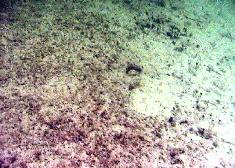 | ||||
Left: frame from underwater video of apparent toolmark in center of photo. The second toolmark is to the lower right. | ||||
University of Leiden Physics Staffmember Analyzes the Andros Platform and the Bimini Road: Both formations likely manmade; identifies 7 toolmarks at ancient Peruvian sites identical to one on Andros Platform. By Dr. Greg Little Dr. R. Zweistra, a computer expert in the Department of Physics at the University of Leiden, Leiden Institute of Physics (Netherlands), has found an unusual and intriguing method of teaching critical thinking skills to students. Dr. Zweistra uses what he terms the "Alternative Archaeology Collection" website to explain the scientific method and point out two extremes in making analyses: "Archaeology is one of the sciences where two extremes of the human thinking come to the fore. At one end there are the short-sighted and frightened cowards who react at things that may challenge their inner world with disheartening stubbornness. And at the other end there are the disheveled dreamers that see in every little thing that cannot be explained immediately as proof of the existence of gods, ghosts, or travellers from outer space. Now this does not mean to say that there may not have been gods, ghosts, or travellers from out of space on earth, merely that the evidence has to be judged by the usual scientific method, and not prejudged by one of the mentioned attitudes..." Zweistra explains that the possible existence of "underwater cities" is archaeology's equivalent to claims of ancient extraterrestrial visits to earth. On the one hand, there are those who reject all such claims because current archaeological theory asserts that such structures are impossible. On the other hand, there are proponents who see every underwater stone as evidence of Atlantis. But Zweistra notes that most of what remains of the truly ancient world is stone, and that is what would likely survive from still older cities that long ago went under the seas. Of course, no other scientific field approaches physics in its ability to continually disprove its long-hallowed ideas. Modern physics has clearly taken itself into the realm of what is incredible to everyone and unthought of only a few decades ago. Zweistra invites students to let go of their pre-conceived notions and critically examine the evidence of a host of underwater sites and simply employ the basic scientific method. The method is a simple but effective way to teach analytical skills. He invites students to come to their own conclusions before looking at his summary. Zweistra presents the Bimini Road and the Andros Platform as two such examples. He touches upon the idea that the Bimini Road could be natural beachrock that fractured in place, but essentially rejects the idea. In brief, his analysis is similar to that we used when examining large areas of beachrock at Bimini. Some Bimini beachrock is square and rectangular, but very, very little. We had read a geologist's claim that there were vast areas of square and rectangular blocks of beachrock there, but we never found more than 2-3 pieces. The same can be said for Andros. In fact, relatively few of the Bimini Road stones have ever been geologically examined. Regarding the Bimini Road and Andros Platform, Zweistra believes that the weight of the evidence is on the side of the formations being manmade. In addition, the apparent toolmark we found on the Andros Platform was of special interest to the physicist. Examining a host of photos from ancient Peruvian sites, he found seven identical square (apparently) toolmarks on stones. The purpose of the square toolmarks is unknown, but the occurrence of them in Peru and on the Andros structure is certainly intriguing. In closely examing our underwater photo of a toolmark, he found another one! Regarding the Andros Platform, Zweistra writes: "As can be seen in the pictures, the stone blocks fit quite precisely. For this to occur naturally is possible, but then it would be over a limited area, mixed with areas where the fragments would not fit. Though the overall picture isn’t complete enough to make a definite judgement, the chances of it being artificial are considerably larger than the chances for it to be natural..." Dr. Zweistra website has excellent picture galleries of Andros, Bimini, and Yonaguni, as well as touching upon structures near Taiwan and the Cuba site. Links to several of the underwater sites Dr. Zweistra discusses are below: Photo gallery and analysis of the Andros Platform | ||